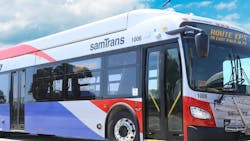SamTrans approves agreement to build charging infrastructure for growing electric bus fleet
The San Mateo County Transit District (SamTrans) Board of Directors voted to approve an agreement to build charging stations for its expanding fleet of battery-electric buses. The agency says it is a major step toward its goal of operating a 100% zero-emission fleet.
Under the $36.3 million agreement with Clark Construction Group, SamTrans will install high-capacity chargers, overhead pantograph dispensers and upgraded electrical and communications systems at its South Base operations and maintenance facility in San Carlos, Calif. This first phase will power the agency’s 37 battery-electric buses operating out of the South Base facility, while laying the groundwork to support up to 110 additional zero-emission vehicles in the future.
“This investment is about more than just buses—it’s about cleaner air, healthier communities and a more sustainable future for San Mateo County,” said SamTrans Director of Infrastructure Zhiming Fan. “By building the infrastructure now, we’re ensuring that zero-emission transit will be the backbone of our service for decades to come.”
The project also includes South Base entrance improvements and will be built under a project labor agreement with local craft unions.
Funding for the project comes from a combination of federal and state sources, including the Federal Transit Administration (FTA), the Bay Area Air District (BAAD), the California Local Partner Program Competitive (LPP-C) fund and the Low Carbon Transit Operations Program (LCTOP). The board also approved a $13.9 million increase to the fiscal year 2026 Capital Budget to incorporate newly awarded grants.
Construction at South Base will begin later this year. When complete, the agency says the new charging infrastructure will position SamTrans to expand its zero-emissions service, reduce greenhouse gas emissions and improve air quality for the communities it serves.
SamTrans began its transition to zero-emission vehicles as part of its Innovative Clean Transit Plan, adopted to meet the California Air Resources Board’s requirement for all public transit agencies to operate a 100% zero-emissions fleet by 2040.
